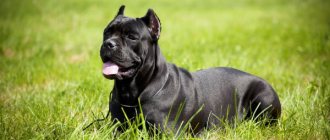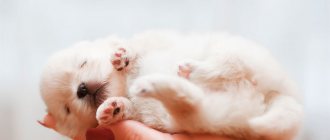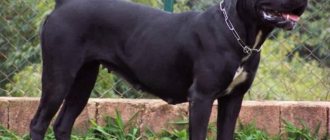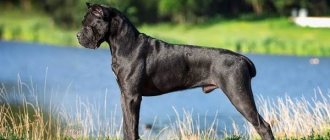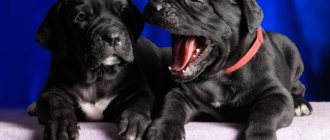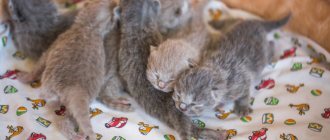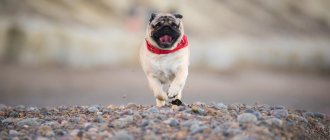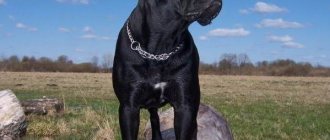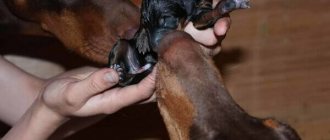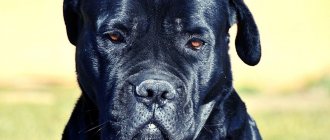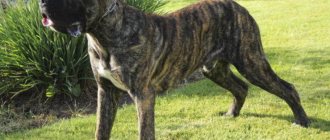It is quite difficult for an inexperienced dog breeder to choose a Cane Corsa puppy, focusing purely on its external characteristics.
He takes into account the secondary characteristics of the dog: the intensity of the color, the length of the ears and tail.
The breeder himself can choose a suitable dog.
If the future owner wants to personally pick up a pet, you should pay attention to the following points:
- the puppy’s development should correspond to its age;
- It is preferable to choose a well-fed pet rather than a thin one (but the stomach should not be bloated);
- The puppy's behavior should be active and cheerful. Lethargy indicates health problems in your pet.
- It is necessary to carefully examine the puppy's coat, eyes, ears and limbs.
A misconception is the idea that all puppies are the same from birth and the cost is set by breeders depending on the prestige of the kennel.
Pedigree Cane Corso puppies are divided into three categories (varieties):
- Pet category dogs (pets). How much they can cost depends on the place of sale, on average from $300 to $500. These dogs are not suitable for breeding and cannot take part in exhibitions.
- Breeding category dogs. How much do dogs intended for exhibitions and breeding cost? On average, the price for the breeding category is up to $1000.
- The price of an elite dog in the show category, born champions, is above $1000, and there is usually a long waiting list for them.
For the proper development of a dog, it is necessary to begin training from the first day of arrival in the family.
The owner should also monitor the pet’s weight gain, adjusting the diet if necessary.
Let's consider the main stages of development of Cane Corsu dogs, as well as the features of education in each period.
Puppies after birth (up to 14 days)
During this period, the puppy has only physiological needs: to eat, sleep and be warm.
From birth, the puppy can turn its head and move in a circle. This is quite enough to find mom - a source of food and warmth. The weight of a newborn puppy ranges from 300 to 700 grams.
The pace of weight gain is especially important, because even puppies with a high birth weight may subsequently not keep up with their peers in development.
On day 12, the kitten's eyes should open completely . My vision is pretty weak at the moment.
The intermediate stage is considered to be three weeks of age. During this time, vision improves and hearing appears, as evidenced by the puppy twitching at sharp sounds.
The kitten can already confidently stand, stomp and eat mushy food. The connection with the mother is still close.
Nutrition
In order for your pet to feel physically good, it is necessary to follow a nutritious diet. The amount of food intake, as well as the portion of food, depends on the age of the pet. Owners choose the following types of dog food:
- Dry. A product that is safe for health is expensive, but the owner is freed from regularly preparing a menu for the animal. The finished product contains vitamins, nutrients, and microelements. An experienced veterinarian will help you choose the right dryer. If required, the doctor will recommend additional medications.
- Natural. This is an inexpensive option compared to dry food. The main advantage of healthy food is that the owner knows what the dog is eating. Optimal nutrition: cereals, vegetables, meat (low-fat varieties are used), milk, fish.
During pregnancy, the bitch's diet is changed 14 days before giving birth. It is allowed to purchase vitamins or special food. For the first 7 weeks, the dog eats according to its usual diet, and then the daily portions are gradually increased (attention is paid to cereal products).
Memory period (4-7 weeks)
During this period, the puppies are too sensitive, they develop conditioned reflexes, which means that the puppies are quite ready for learning and training.
By the age of two months, the puppy’s weight should be from 6 to 8.5 kg. Incorrect and untimely adaptation can become a prerequisite for problems in the pet’s relationship with the outside world.
At this stage, it is worth observing the crumbs and determining the character of the future adult dog: who is the entertainer, the leader, and who is the impressive couch potato.
Weak kittens must be taken under guardianship; bullies are simply observed, distracted, and not punished.
In the future, he can grow into a champion, the pride of the owner. By forbidding a dog to communicate with other people, the owner makes a mistake. Subsequently, the puppy may become fearful or even aggressive.
It will become almost impossible to change your behavior. Suspiciousness and distrust are unacceptable traits for a domestic dog.
Character
Most often, the character of an animal can be judged by the task for which it was bred. It’s difficult in this regard with Cane Corso: over their long history, they have managed to be fighting dogs, shepherds, security guards, bodyguards, and just friends. Therefore, their features do not have a clear connection to any one purpose.
- devotion. The Cane Corso is one of those breeds that choose one owner and remain loyal for life. Of course, they will love the owner’s children, their partner, their elderly parents, and even their beloved canary, but they will all forever remain in second place. This does not affect behavior; the dog is equally obedient to all family members. But it affects the feelings: if the owner leaves, the Corso will be sad and even increased attention from other familiar people will not be a consolation. That’s why dogs have a hard time coping with a change of owner. Sometimes it happens that the new owner cannot take the place of the old one in the dog’s heart.
- equilibrium. If a large animal flinches at every rustle, is nervous and easily excitable, it will become dangerous. That’s why Corsos are quite phlegmatic and cope well with stress. Their peace of mind is not shaken by loud arguments, moving, children trying to play with their tail, or sudden loud noises. Only disapproval or absence of the owner can seriously affect the dog’s condition.
- security qualities. Even an untrained Corso exhibits the habits of a guard. He is suspicious of strangers, does not allow strangers near the owner’s children and property if the owner himself is not around, and does not like familiarity. There is no prohibition against aggression towards humans in his genes, therefore, if his charges are in danger, the dog will protect them at all costs. It’s not scary to let the children go out with him.
- caring. These are echoes of the times when Corso lived in peasant families, looked after herds and looked after children. Since then, they get along well with other dogs and small animals. They feel a reverent love for children and are happy to look after the kids, play with them and have fun.
These are smart, calm dogs who obey their loved one not out of fear, but out of conscience, and are surprisingly flexible for their size. All that is required from the owner is to explain the rules to the Corso, show what needs to be feared in the world around him, and what is harmless, and not spoil anything in the psyche.
Advantages and disadvantages
The advantages are the following:
- They are excellent guards and defenders. With them you don’t have to worry about your home, and when you go out for a walk at night, you don’t have to worry about meeting bad people.
- They are very smart and flexible. Even with teenagers there are usually no problems.
- They are happy to benefit. Carry shopping bags? Keep an eye on small children? Drive away a stranger? Corso will be happy to do this.
- They lack hunting instincts. They won’t chase cats, try to grab every squirrel in the park and be distracted by unfamiliar smells. They get along easily with other animals.
There is little that can confuse or frighten them - their psyche is stable and able to cope with stress, especially if people are ready to help a little.
But everything is never perfect, which means there are also disadvantages:
- The dog will need adequate training. He must distinguish where the owner is being attacked and where they just want to hug him, he must not be afraid of the city and must neutralize the stranger, and not try to bite him to death. To do this, he will have to take courses where he will be trained as a defender. And even earlier, you will need to be able to explain to the baby what is possible, what is not, when a person is happy and when he is not. And this will require not only time, but also strength and patience.
- Will need care. Corsos shed constantly, so you will have to devote time to caring for the coat. They also eat a lot, simply because of their size, and the food must be of high quality.
- You will need attention and love. This is not a dog that can live in a yard or mind its own business most of the time. She needs to be close, interact, play, or at least lie at her feet, enjoying the presence of her person.
- Long, pleasant walks are needed. You need to run, play and exercise with the animal so that it has time to get exhausted and when it comes home it just falls asleep. Therefore, it is not suitable for the sick, the elderly and not very active people.
Due to the structure of the muzzle, the Corso constantly salivates - this is typical for flat-faced mastiffs in general. The fur also gives off a faint dog smell, and individual hairs constantly fall around. Therefore, they are not suitable for people who like sterile cleanliness to reign in their home.
Understanding society (2-3 months)
This is the best period for weaning a puppy from its mother and brothers; getting to know and getting used to the new owner. The puppy needs to see all the diversity of the world around him.
During this period, the pet is the most gentle, inquisitive and sociable.
He studies any situation with interest: in the apartment it is the noise of a vacuum cleaner, the sound of a microwave oven, a telephone signal; on the street - the noise of wind, rain and other little things.
When meeting a stranger, the puppy runs up without fear and trustfully examines the new object.
At this stage, the puppy has a developed desire to learn . Don't miss this moment.
Having memorized the nickname, you need to move on to mastering the basic commands: “fu”, “place”, “come to me”, “sit”, “lie down”.
During this period, the pet must be handled carefully (they are too sensitive and vulnerable), avoid stressful moments, encouraging the Kange Corso with treats.
For the proper development of a puppy, it is necessary to pay attention not only to the upbringing, but also to the feeding of the pet.
It is worth adding that at three months of age the puppy should have five meals a day, including meat, dairy products and cereals.
At this age, the weight of a male puppy should be from 12 to 14 kg, and for a female puppy - from 10 to 13 kg.
Weight and height from 1 to 12 months
First
Puppies are actively exploring the world. Become more mobile .
At this age, it is already possible to determine the character of the pet; some become restless and inquisitive, while other puppies, on the contrary, are lazy.
During this period they weigh 6-8 kg . The height of a one-month-old puppy is within 25 cm.
Second
During this period, you can gradually wean the puppy away from its mother and siblings.
The baby's curiosity increases, he needs to stick his nose everywhere.
The weight of a 2-month-old Cane Corso is about 9 kg, height is 32 cm.
Third
At this age, learning ability increases.
In addition to remembering its name, the puppy can master simple commands for action.
A dog at three months already weighs a lot, it’s about 13.5 kg.
Height reaches 42 cm at the withers.
Fourth
During this period, the dog tries to dominate, begins to growl and even bite during the game.
Cane Corso already weighs from 16 to 18.5 kg, grows up to 47 cm.
Period of perception (4 - 6 months)
By the end of this period, the recommended weight of dogs should be: 24-28 kg for females, 26-32 kg for males.
Having matured, the baby begins to explore leadership in the family, trying not only to growl, but also to bite the owner during active games.
Thus, he is aware of the hierarchy in the family. At this stage, the puppy is formed as a family pet; every family member, including children; must be an authority for the dog, a leader.
After learning the basic commands, training should continue systematically and include more complex tasks..
Most male dogs exhibit high sexual activity, manifested by jumping on the legs of the owner or other dogs.
This is a natural phenomenon for which the pet should not be severely punished (perhaps in the future the owner plans to use the pet as a breeder)
What to do if your weight is below normal
An underweight dog indicates health problems. The first thing the owner must do is get his pet’s blood and urine tested.
Perhaps deworming was carried out incorrectly, the wrong drug was selected or the timing of the drug was administered.
If helminthic infestation was not detected, then the cause should be sought in a chronic or inflammatory process in the body.
For a dog of this breed, the problem may be related to the liver or intestinal tract . A veterinarian will help solve all these problems.
Another reason for a puppy’s weight loss is improperly selected food. Everything is not as harmless as it seems.
These circumstances may not have the best effect on the animal’s liver, since such foods contain a lot of protein, which negatively affects the puppy’s growing body..
The young liver is not able to process large amounts of protein, resulting in hepatitis and hepatosis.
Some unscrupulous manufacturers produce low-quality food or put synthetic additives in it that cause addiction in the animal.
As a result, food allergies and liver damage develop.
In this case, you should urgently change the dog’s diet and show your pet to a veterinarian to diagnose the dog’s liver and other internal organs..
Puberty (up to 8 months)
At this stage, Cane Corso puppies can express greater independence, trying to assert themselves.
They may not take into account commands that they previously carried out with ease.
When raising a pet, it is necessary to show persistence and steadfastness, to demand absolute obedience in order to eradicate the likelihood of disobedience. This stage is the final stage in the development of pet subordination.
A jealous position towards other family members (including children); independent choice of direction of movement during walks.
Hostile upholding of one’s own rules in the house must be nipped in the bud in the form of an ultimatum. In these situations, the dog should not feel like a leader.
The weight of pets at the age of eight months should be 34-36 kg for females, 38-40 for males.
Between 6 and 14 months of age, Cane Corso puppies may experience feelings of fear. While walking, he may be frightened by a completely familiar object or sound.
In this situation, the owner needs to show restraint and calmness, explaining to the pet that the object is not dangerous at all.
At the age of one year, these massive pets, weighing 38-43 kg for females and 44-46 kg for males, can behave like naive babies.
Content
The excellent health of the Cane Corso allows him to get along well in the city and in a private home. The owner needs to monitor the condition of the dog's eyes and ears and clean them regularly.
Need for physical activity
The owner's key responsibility towards the dog is to keep it healthy. Walk your Corso every day for 2 hours a day. To keep your dog entertained while walking, engage in training. Learn the commands “fetch” and “come to me”, and then include more complex exercises. Buy balls and throw them during walks to keep your pet in physical shape.
Walk pregnant Corso bitches three times a day, without giving excessive stress. Nursing mothers will have to be walked 4-5 times a day for 15 minutes.
Appearance care
The Cane Corso's coat, although short, requires care. To maintain shine, clean the hide with a brush and wipe with a sponge. Before brushing, massage your dog with light hand movements against the fur to identify particularly dirty areas. Start the procedure from the back, smoothly moving towards the limbs.
Clean your ears and eyes twice a week with a cotton pad soaked in lotion from the veterinarian.
Nutrition
The Cane Corso's diet is no different from that of other dog breeds. Feed your pet dry kibble or natural foods. Natural food is cheaper, but preparation is time-consuming. Also, to maintain your dog’s health, you will have to maintain a balance of proteins, carbohydrates, vitamins and fats in the food.
Ready-made food is much more expensive, but it saves time on selecting and combining ingredients.
Turning age (1-4 years)
After mating, Cane Corso dogs (especially males) again have a desire to take leadership positions.
Former comrades walking peacefully in the same yard strive to fight, finding out who is stronger.
Having great physical strength, the Cane Corso will be able to fight back and even cripple an opponent who is several times larger than him in height and weight.
The owner should not be frightened by this behavior; the most important thing is not to follow the pet’s lead, thereby allowing him to gain leadership.
It is necessary to treat the dog firmly and at the same time friendly . The process of education and training should be constantly carried out.
After puberty, dogs do not complete development; behavioral characteristics may change until the age of three.
It should be noted that the standard weight at 2 years is 38-45 kg for females and 48-55 kg for males.
Adult dog weight
Cane Corso is a rather large dog. Traditionally, males are slightly larger than females.
So, if we talk about the height at the withers of dogs, then their parameters will be as follows:
- height of males – 64-68 cm;
- height of females is 60-64 cm.
Accordingly, there is a difference in weight, which is approximately 5-10 kg.
A male dog has a body weight of 45-50 kg, and sometimes more. Female – 40-45 kg.
If the readings are lower, it means something is wrong with your pet; it would be a good idea to take him to the veterinarian.
Photo gallery
The main calling of the Cane Corso dogs, which you can see in the photographs below, is to guard and protect the owner, children and all family members. They become a good nanny and companion.
Disadvantages and defects of the Cane Corso
Like any other breed, a deviation from the standard is a minus for a particular animal, and the greater the severity, the impact on appearance and health, the more serious the defect is considered. The following are considered significant shortcomings or defects in the Cane Corso:
- the longitudinal lines of the muzzle and skull from above are parallel to each other or converge at too large an angle;
- incomplete pigmentation of the nose;
- excessively massive cheekbones;
- undershot more than 5 mm;
- scissor bite;
- ring or vertical tail;
- large deviation in growth parameter at the withers;
- the presence of a dewclaw - a rudiment, the 5th finger, which is located above the foot;
- incorrect running is a trot, which is periodically replaced by an amble (a horse's way of running, when first both left limbs are carried forward, and then both right ones).
A straight bite is not considered a serious disadvantage, but it is also not encouraged.
Disqualifying faults
There is a list of the most serious deficiencies that become a reason to disqualify an animal from participation in exhibitions and breeding work:
- semi-long coat, fringed tail and hips;
- behavioral deviations (aggression or excessive shyness);
- undershot;
- diverging upper lines of the skull and muzzle;
- complete absence of pigment on the nose, complete or partial depigmentation of the eyelids;
- humpbacked or bent nose;
- strabismus;
- eyes interspersed with blue spots;
- absence of a tail;
- short tail;
- too large white spots;
- coat color not included in the standard.
